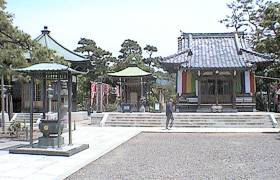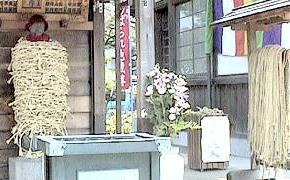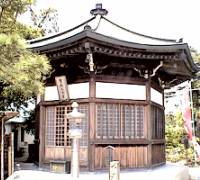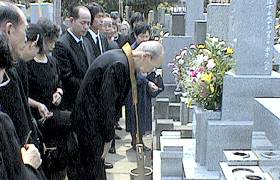

When he awoke, he discovered that the cart was gone, along with its load. In a panic he rushed to the magistrate's office. An investigation was carried out by then-renowned magistrate Oh-oka Echizen. The magistrate said, "Jizo is guilty for his negligence in keeping watch, letting the robber escape," and ordered the stone statue of Jizo to be bound tightly with rope.
Word of the trial spread, and many spectators thronged to the yard of the magistrate's office. Then the magistrate tactically ordered the gate closed, and said, "Breaking into the divine court is unforgivable. As punishment, each of you is fined a roll of cloth."
When the clerk checked the collected rolls of cloth, he found a stolen one among them. This lead to the arrest of a notorious ring of thieves.
 The Jizo is said to grant all wishes, including protection from robbery, making someone stay with you (or maybe stay away), protecting you against evil, and matchmaking. When you make a wish, you bind the Jizo with rope. After your wish comes true, you untie the rope.
The Jizo is said to grant all wishes, including protection from robbery, making someone stay with you (or maybe stay away), protecting you against evil, and matchmaking. When you make a wish, you bind the Jizo with rope. After your wish comes true, you untie the rope.On the grounds of the temple was built "Taishi-do" (Shrine for Prince Shotoku). Shotoku (574-622 A.D.) was a prince ("Taishi") who established the first constitution in Japan.
The name of the place where Yasuko Shimizu lived as a newlywed with Kanekichi in Setagaya-ku was Taishido. Is it just a coincidence, or did God lead her there?
 In Buddhism, it is believed that the soul wanders between this world and the next during the forth-nine days immediately after death.
In Buddhism, it is believed that the soul wanders between this world and the next during the forth-nine days immediately after death.On a sunny day in May 1998, the memorial service for the forty-ninth day after her death was held at Nanzoin Temple. There gathered her five children, grand children, kinfolk, and her students of Washi-E, and the funeral ashes of her remains were laid into the newly built gravesite of the Shimizu family. The man in the center is her husband Kanekichi.
On December 20, 2000, Kanekichi passed away at age of 96, to see his wife again in Heaven.
 Yasuko Shimizu
Yasuko Shimizu